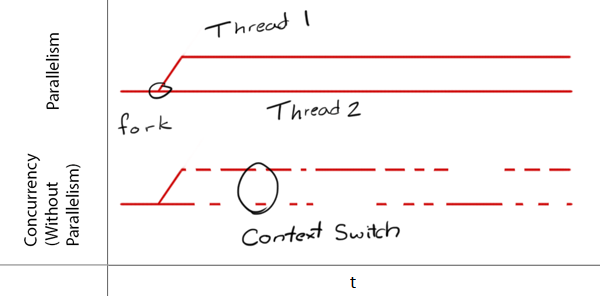DPS921/Halt and Catch Fire
Contents
Halt and Catch Fire
Project: Parallelism with Go
Group Members
- Colin Paul [1] Research etc.
Progress
Oct 31st:
- Picked topic
- Picked presentation date.
- Created Wiki page
Nov 28th:
- Presented topic
Parallel Programming in Go
What is Go?
- The Go language is an open source project to make programmers more productive.
- It is expressive, concise, clean, and efficient. Its concurrency mechanisms make it easy to write programs that get the most out of multi-core and networked machines, while its novel type system enables flexible and modular program construction. Go compiles quickly to machine code yet has the convenience of garbage collection and the power of run-time reflection. It's a fast, statically typed, compiled language that feels like a dynamically typed, interpreted language.
By what means does Go allow parallelism?
- Go allows multi-core programming using concurrency methods, and enables the ability to parallelize.
TLDR;
What is parallelism?
- Programming as the simultaneous execution of (possibly related) computations.
What is concurrency?
- Concurrency is the composition of independently executing computations.
- It is a way to structure software, particularly as a way to write clean code that interacts well with the real world.
- It is not parallelism, but it enables it.
- If you have only one processor, your program can still be concurrent but it cannot be parallel.
- On the other hand, a well-written concurrent program might run efficiently in parallel on a multi-processor.
Concurrency vs parallelism
- Concurrency is about dealing with lots of things at once.
- Parallelism is about doing lots of things at once.
- Not the same, but related.
- Concurrency is about structure, parallelism is about execution.
- Concurrency provides a way to structure a solution to solve a problem that may (but not necessarily) be parallelizable.
Examples of things that use a concurrent model
- I/O - Mouse, keyboard, display, and disk drivers.
Examples of things that use a parallel model
- GPU - performing vector dot products.
Up and running with Go
Download and installation
Documentation
Playground
Demo: Concurrency and parallelism in Go
Monte Carlo Simulations
- A probabilistic way to come up with the answer to a mathematical question by running a large number of simulations when you cannot get or want to double-check a closed-formed solution.
- Use it to calculate the value of π (pi) - 3.1415926535
Method
- Draw a square, then inscribe a circle within it.
- Uniformly scatter some objects of uniform size (grains of rice or sand) over the square.
- Count the number of objects inside the circle and the total number of objects.
- The ratio of the two counts is an estimate of the ratio of the two areas, which is π/4. Multiply the result by 4 to estimate π.
Pseudo implementation
- To make the simulations simple, we’ll use a unit square with sides of length 1.
- That will make our final ratio of: (π*(1)2/4) / 12 = π/4
- We just need to multiply by 4 to get π.
Implementation
Serial
func PI(samples int) float64 {
var inside int = 0
r := rand.New(rand.NewSource(time.Now().UnixNano()))
for i := 0; i < samples; i++ {
x := r.Float64()
y := r.Float64()
if (x*x + y*y) <= 1 {
inside++
}
}
ratio := float64(inside) / float64(samples)
return ratio * 4
}Parallel
func MultiPI(samples int) float64 {
runtime.GOMAXPROCS(runtime.NumCPU())
cpus := runtime.NumCPU()
threadSamples := samples / cpus
results := make(chan float64, cpus)
for j := 0; j < cpus; j++ {
go func() { // spawn goroutine
var inside int
r := rand.New(rand.NewSource(time.Now().UnixNano()))
for i := 0; i < threadSamples; i++ {
x, y := r.Float64(), r.Float64()
if (x*x + y*y) <= 1 {
inside++
}
}
results <- float64(inside) / float64(threadSamples) * 4
}()
}
var total float64
for i := 0; i < cpus; i++ {
total += <-results
}
return total / float64(cpus)
}
